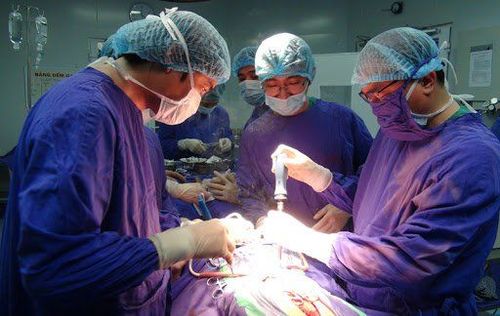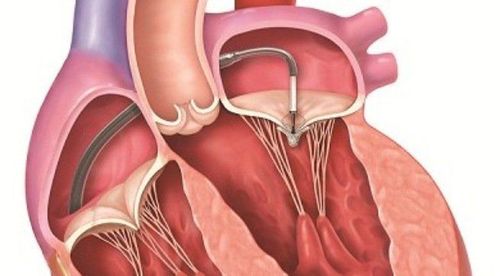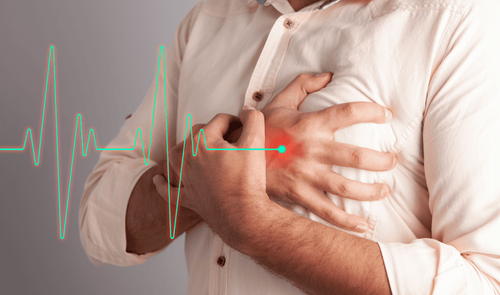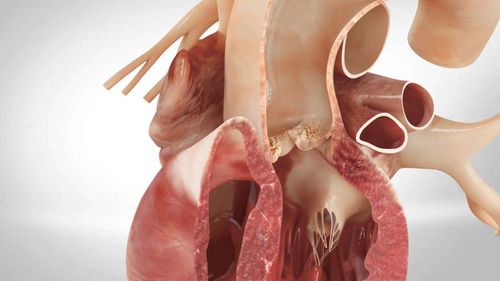This is an automatically translated article.
The article is professionally consulted by Master, Doctor La Thi Thuy and Master, Doctor Tran Hong Nhat - Interventional Cardiologist - Cardiovascular Center - Vinmec Central Park International General Hospital.The incidence of aortic diseases worldwide has increased in recent decades. Specifically, over the past 3 decades, the prevalence has increased 3-fold.
1-5% of the general population are diagnosed with the disease 4-8% of men aged 60 Approximately over 25,000 annual deaths are related to the disease. Aortic involvement is reported annually in the United States. The 13th leading cause of death of all causes of death from disease
Incidence increases with age:
4.8% men aged 65-69 10.8% men 80-83 years 1- 2.2% female
1. Anatomy of the aorta
The aorta is the main and largest artery in the human body, shaped like a stick. The curved portion extending up from the heart branches into vascular branches that supply blood to the head and arms. Then, the aorta descending through the chest and abdomen divides into blood vessels that supply blood to the abdominal organs and legs.The aorta has two segments:
Thoracic aortic segment: The thoracic aorta further divides into ascending aorta, arch of the aorta, and descending aorta. The arch of the aorta gives out all branches of the brachial artery
Abdominal aortic segment: The abdominal aorta includes the superior renal and subrenal aortic segments.
The aorta plays a major role in maintaining blood circulation during diastole after they are pushed into the aorta by the left ventricle during systole.
Aortic diseases include:
Aortic valve disease: 2-piece aortic valve, aortic stenosis or aortic regurgitation Aortic aneurysm: An aneurysm is an abnormal bulge in the wall of the aorta. . This aneurysm is a weak point in the aorta that can rupture causing life-threatening internal bleeding Aortic dissection: Aortic dissection occurs when the cell wall of the aorta (intima-medial layer) - coat) tear begins in the endothelium called the blood flow entry point separating the intima creating a "false lumen", which can grow and rupture Atherosclerosis: Also known as a blocked artery blockage or “hardening of the arteries”. The accumulation of cholesterol and fats in the artery walls along with high blood pressure causes atherosclerosis. Severe atherosclerosis can damage the aortic wall Aortic inflammation: Inflammatory diseases, such as Takayasu's arteritis, can block blood flow through the aorta and weaken the artery wall. owner. Connective tissue disorders: Patients with Marfan syndrome, Ehler-Danlos syndrome, and other inherited connective tissue disorders have a predominant artery wall that can rupture or tear.
2. Common aortic diseases
Although the most powerful in the vascular system, when the aorta has abnormalities such as aneurysms, dilation, it is very dangerous, life-threatening.The elasticity of the aorta contributes primarily to the maintenance of its normal function. However, the elasticity and distension of the aorta decreases with age. This change occurs in normal people. Loss of ability to stretch and dilate increases pulse pressure commonly seen in the elderly and is followed by a gradual dilation of the aorta. Loss of elasticity with age progresses more rapidly in people with hypertension, hypercholesterolemia, or coronary artery disease than in the general population. In contrast, in athletes, the elasticity of the aorta was higher than in other people of the same age.
2.1. Aortic valve stenosis
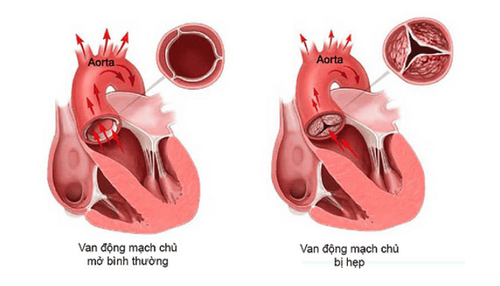
Động mạch chủ bình thường và hẹp van động mạch chủ
When the leaflets are mildly thickened or rough (aortic fibrosis) or dilated aorta can produce a typical murmur and flutter without causing marked hemodynamic disturbance.
In mild or moderate disease, the characteristic sign is a systolic murmur in the aortic valve region that radiates up the neck and down the apex. In severe cases, left ventricular palpitations or fibrillation may be markedly palpable, and the second tone of the aortic valve is predominant either absent or reversed bifurcation of the second sound.
Normally the valve area is 3-4cm2, when the valve area is less than 0.8-1cm2, the ventricular systolic period is longer and the slow and weak bouncing pattern is typical of the carotid artery, however this sign unreliable in elderly people with severe arteriosclerosis. Left ventricular hypertrophy gradually increases, leading to increased diastolic pressure. Cardiac output is maintained until the valve is severely stenotic, with an orifice area less than 0.8 cm2. Patients may have left ventricular failure, chest pain, or syncope. Symptoms of left ventricular failure may develop gradually.
2.2. Aortic aneurysm
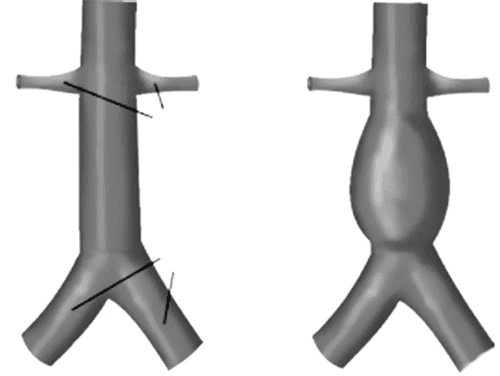
Động mạch chủ bình thường và phình động mạch chủ
Symptoms of abdominal pain, pain usually located in the lower abdomen or back. The pain is often constant, excruciating and lasts for hours to days. In contrast to musculoskeletal pain in the back, movement does not affect the sensation of aneurysm pain, although in certain positions the patient may also feel more comfortable.
The emergence of new or increased pain that often comes on suddenly may herald further dilatation or threat of rupture of the aneurysm. The pain in the aortic aneurysm is characterized as: constant pain that does not go away, is severe, and is localized in the back or lower abdomen. The pain may radiate down the groin area, into the hip area, or down the leg. A ruptured aneurysm is actually accompanied by a sudden onset of back pain along with abdominal pain and abdominal distension. Most patients have a mass, palpable in the abdomen, and pulsating heart rate with hypotension that is considered characteristic of an abdominal aortic aneurysm.
Abdominal aortic aneurysms with signs of threatened rupture, the patient has sudden severe abdominal pain, similar to other acute abdominal conditions such as renal colic, appendicitis, or gastric bleeding - intestine.
Blood loss and complications of ruptured aortic aneurysm can happen quickly. Retroperitoneal bleeding may present with hematoma in the flank and inguinal region. Rupture into the peritoneal cavity can lead to abdominal distension, while rupture into the duodenum presents with massive gastrointestinal bleeding. Blood flow through the aneurysm is disturbed and blood clots can form along the artery wall. This blood clot, along with atherosclerotic fragments, can travel through the bloodstream causing embolism and affecting the circulation of the distal arteries.
However, ruptured aortic aneurysm is the most dangerous. When rupture of an aortic aneurysm occurs, up to 80% of cases rupture into the left posterior peritoneum and can partially limit rupture, while in most cases rupture into the peritoneal cavity. and cause uncontrolled bleeding leading to rapid cardiovascular collapse.
2.3. Aortic dissection
Aortic dissection, also known as aortic dissection, is a real tragedy for patients. Starting from a tear in the endothelium called the blood flow entry point, it separates the middle mantle to form a "false lumen". A false lumen develops along the path of the aorta, narrowing, occluding, or rupturing the branches of the aorta. Branches when broken will create a secondary entry point, blood flow will flow in the pseudoluminal from the primary point to the secondary, preventing thrombus formation in the false lumen.Pain like tearing the chest has the nature of moving, pain can spread to the back appear suddenly, the pain nature is easy to think of a heart attack. The patient may lose or weaken pulse in the arms or legs. In addition, there are other clinical symptoms that the examiner may detect.
Paraclinical investigations can suspect or "see" the tear site and false lumen of the dissected blood vessel such as: echocardiography, transesophageal echocardiography, CT - Scanner, magnetic resonance imaging (MRI) .
In general, with such acute and severe symptoms, patients almost always go to the doctor, the problem of early detection belongs to the grassroots doctors.
3. Prevention of aortic disease

Ngưng hút thuốc lá để có lối sống và sức khỏe lành mạnh
Lifestyle changes to limit the risk of aortic disease as well as dangerous complications such as heart failure, myocardial infarction. The advice is:
Stop smoking and avoid secondhand smoke, say no to alcohol. Stay away from fast foods, foods high in fat, salt and sugar. Eat more vegetables and fruits and foods high in fiber such as whole grains, nuts, legumes, fruits, green vegetables, etc. Lose weight if you are overweight. Spend more time walking and being physically active. However, people with cardiovascular disease need to discuss carefully with their doctors to choose the right form of exercise and intensity for their health status. Timely check and treat diseases related to coronary heart disease such as diabetes, overweight, obesity, hypertension, dyslipidemia,... Build a positive, happy, healthy lifestyle calm, avoid excessive stress, work in moderation,... Aortic disease often progresses very quickly with many dangerous diseases requiring timely and effective treatment. Today, in Vietnam, life expectancy is increasing, the population of the elderly is also increasing, so the elderly need to pay attention to blood pressure control, medical examination, basic blood tests and periodic ultrasound of the pulse to detect early diseases. aortic disease for timely prevention and treatment, to avoid serious complications and death. Abdominal aortic aneurysm and aortic dissection are two common diseases among aortic pathologies with high mortality from rupture of aortic aneurysms.
Please dial HOTLINE for more information or register for an appointment HERE. Download MyVinmec app to make appointments faster and to manage your bookings easily.





